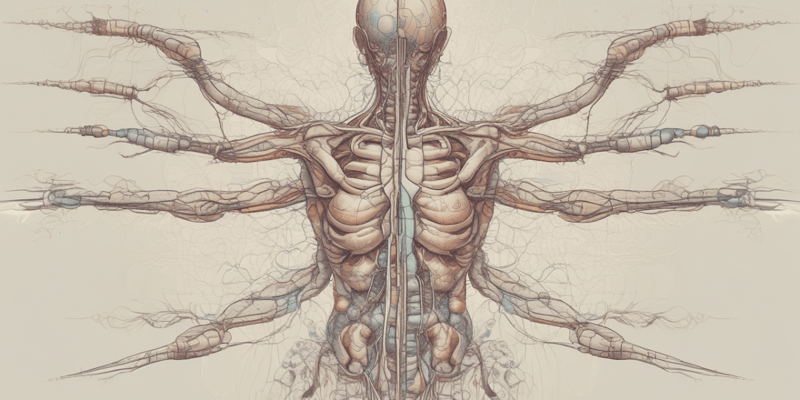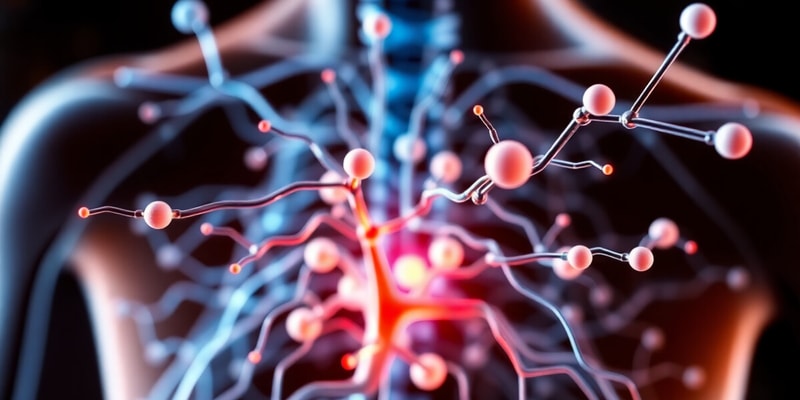Podcast
Questions and Answers
Which neurotransmitter is released by preganglionic fibers in the autonomic nervous system?
Which neurotransmitter is released by preganglionic fibers in the autonomic nervous system?
The sympathetic nervous system primarily uses acetylcholine as its primary neurotransmitter.
The sympathetic nervous system primarily uses acetylcholine as its primary neurotransmitter.
False
Name one type of receptor associated with the cholinergic system.
Name one type of receptor associated with the cholinergic system.
Nicotinic or Muscarinic
The _______ system is responsible for the 'fight or flight' response.
The _______ system is responsible for the 'fight or flight' response.
Signup and view all the answers
Match the following adrenergic receptors with their primary function:
Match the following adrenergic receptors with their primary function:
Signup and view all the answers
Which component is not part of the efferent division of the autonomic nervous system?
Which component is not part of the efferent division of the autonomic nervous system?
Signup and view all the answers
The autonomic nervous system is a part of the peripheral nervous system.
The autonomic nervous system is a part of the peripheral nervous system.
Signup and view all the answers
What are the two branches of the autonomic nervous system?
What are the two branches of the autonomic nervous system?
Signup and view all the answers
Postganglionic fibers of the sympathetic nervous system primarily use ______ as their neurotransmitter.
Postganglionic fibers of the sympathetic nervous system primarily use ______ as their neurotransmitter.
Signup and view all the answers
Which of the following drugs would be classified as antimuscarinic agents?
Which of the following drugs would be classified as antimuscarinic agents?
Signup and view all the answers
Study Notes
Autonomic Nervous System
- The autonomic nervous system is a control system that acts largely unconsciously and regulates functions such as heart rate, digestion, respiratory rate, pupillary response, urination, and sexual arousal.
- It is a part of the peripheral nervous system, and one of its key functions is to maintain homeostasis.
- This system has two main branches: the sympathetic nervous system and the parasympathetic nervous system.
- The sympathetic nervous system is referred to as the "fight or flight" system, and the parasympathetic nervous system is referred to as the "rest and digest" system.
Cholinergic Drugs
- Cholinergic drugs are compounds that act as agonists or antagonists of acetylcholine.
- Acetylcholine is a neurotransmitter that is involved in both the parasympathetic and sympathetic nervous systems.
- Cholinergic agonists mimic the action of acetylcholine, while cholinergic antagonists block the action of acetylcholine.
- Cholinergic drugs are used to treat a variety of conditions, including glaucoma, myasthenia gravis, and Alzheimer's disease.
Adrenergic Drugs
- Adrenergic drugs are compounds that act as agonists or antagonists of norepinephrine (noradrenaline).
- Norepinephrine is a neurotransmitter that is involved in the sympathetic nervous system.
- Adrenergic agonists mimic the action of norepinephrine, while adrenergic antagonists block the action of norepinephrine.
- Adrenergic drugs are used to treat a variety of conditions, including asthma, heart failure, and hypertension.
Key Neurotransmitters and Receptors
- Acetylcholine (ACh): a neurotransmitter that is present in both the sympathetic and parasympathetic nervous systems.
- Norepinephrine (NE): a neurotransmitter that is present in the sympathetic nervous system.
- Nicotinic receptors: found on the postganglionic membranes of both the sympathetic and parasympathetic nervous system, as well as on skeletal muscle (motor end plate).
- Muscarinic receptors: found on the postganglionic membranes of the parasympathetic nervous system.
- Alpha-1 receptors: found on postsynaptic smooth muscle.
- Alpha-2 receptors: found on presynaptic adrenergic nerve terminals.
- Beta-1 receptors: found on the heart.
- Beta-2 receptors: found on smooth muscle.
- Dopamine receptors: found on the kidneys, where they help in regulating blood flow.
Drug Effects
- Pharmacokinetics: The study of the movement of drugs within the body (absorption, distribution, metabolism, and excretion).
- Pharmacodynamics: The study of the effects of drugs on the body.
- Adverse effects: Undesirable effects of drugs.
Studying That Suits You
Use AI to generate personalized quizzes and flashcards to suit your learning preferences.
Related Documents
Description
Test your understanding of the autonomic nervous system and the role of cholinergic drugs. This quiz covers essential functions, including how these systems maintain homeostasis and how cholinergic drugs interact with neurotransmission. Perfect for students of physiology and pharmacology.




